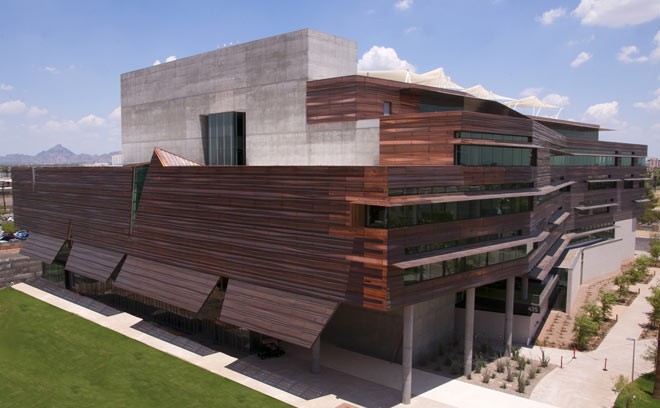Within the flowing copper-shell lines of an ultra-modern building in downtown Phoenix, students motivated by caring for others soon will explore the social connections and learn the professional skills that promise to transform their own lives.
Northern Arizona University students in two high-demand and highly competitive health care fields, physician assistant and physical therapy, are about to launch their graduate studies in the new building, but not without good company.
They will learn shoulder-to-shoulder with medical students from the University of Arizona College of Medicine in a space that defines collaboration.
The Health Sciences Education Building on the Phoenix Biomedical Campus stands out on its own as an eye-catching architectural achievement. But the concept that drove a physical layout deeply intertwined with technology comes down to a very human element.
“This facility is awe inspiring,” said Richard Dehn, professor and founding chair of NAU’s new two-year master’s program in physician assistant studies, which is based at the center. “The natural inclination of students in health professions is to form social bonds on the way to making professional connections, and the architects were thinking of that.”
From an anatomy lab on the sixth floor in which NAU students and their counterparts from the UA will study, to a third-floor shared library, to strategically placed social gathering spots on the second floor, “there is no way to be a student here and avoid running into the other professions,” Dehn said.
Even the extensive technology emphasizes human interaction. On the fourth floor, 24 rooms set up to replicate the clinic rooms of a doctor’s office are fitted with unobtrusive cameras. Students will work with standardized patients—professionally trained to “present” patient-like conditions—while being monitored by faculty from a separate room.
“It’s a way to standardize how students perform in a clinical setting” without a faculty member being present to affect the dynamics, Dehn said.
While the students are expected to thrive in a place so attuned to interactive technology, faculty will experience an opportunity to expand their own horizons, said Kathleen Ganley, associate professor of physical therapy and director of the new Phoenix program.
“The architects have really laid out a challenge for us to consider how we’re teaching,” Ganley said. “Students have so much access to information today that there’s no reason to believe any course is limited to the knowledge bank of the instructor.”
Under the building’s design, classrooms have evolved into learning studios, in which small groups of students can gather to work together on projects and connect, as questions arise, to an instructor via display screens.
In the physical therapy lab—“our pride and joy,” as Ganley calls it—cameras and display screens will allow students across an expansive room full of exercise and testing equipment to receive faculty feedback in real time as they evaluate patients.
“This gives us an opportunity to explore new methods of teaching,” Ganley said. “My job now becomes asking the right questions and synthesizing information and its applicability to patient care.
“It’s mind-boggling that a building can make me think differently about something I’ve been doing for 20 years,” Ganley said. “Here, we can bring the tradition and philosophy from the successful and established program in Flagstaff to a new model of delivery.”
Both Phoenix programs will start small when classes begin there later this month: 25 students have been admitted to physician assistant studies, and 25 more—from an applicant pool that has already reached 1,200—will be admitted in 2013. The program will expand to 50 new students in fall 2014.
The 33-month doctoral program in physical therapy, which will continue to operate on the Flagstaff campus where it was established in 1978, will begin with 24 students, expanding to an annual class of 48 in fall 2014.
According to Rich Bowen, NAU associate vice president for economic development, “The integrated model, with allied health and MDs training together, was NAU’s grand plan some years ago. This building is a big achievement for NAU and the University of Arizona because it establishes a physical presence for us in Phoenix.”
Bowen said that physician assistants and physical therapists are increasingly relied upon as primary care providers, and their current shortage will become acute as changes in health care laws bring access to millions of new patients.
“There’s more pressure to produce students with a higher level of skills,” he said.
And many of those students will likely end up working in Arizona. Particularly with regard to physician assistant program, Dehn said, “Our mission is to train people who are likely to practice in Arizona, and we will do all of our clinical training only in Arizona.”



